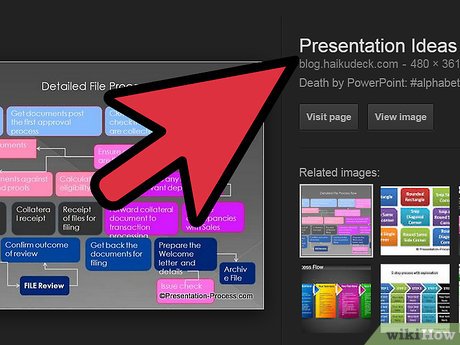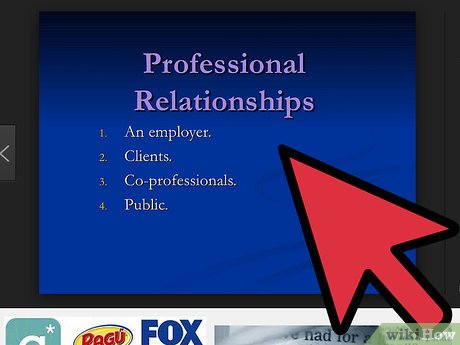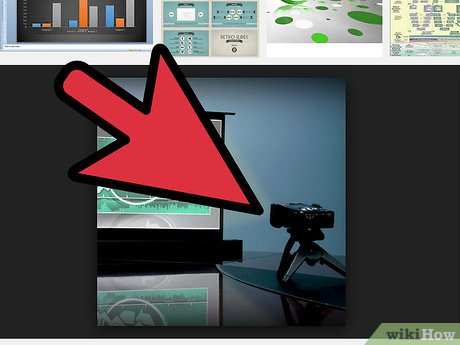How to Develop and Design a PowerPoint Presentation
Sample PowerPoint Presentation
 Sample PowerPoint Presentation for School
Sample PowerPoint Presentation for SchoolMethod 1 of 1:
Developing Your Own PowerPoint Presentation
-
 Treat your audience like a king. They came to find out what you can do for them. You have to convince them that it is in their best interests to do whatever you want them to do, which at the very least is pay attention to the presentation.Also, know the type of your audience (such as college students, workmates or kids etc) in order to better present things that can attract them
Treat your audience like a king. They came to find out what you can do for them. You have to convince them that it is in their best interests to do whatever you want them to do, which at the very least is pay attention to the presentation.Also, know the type of your audience (such as college students, workmates or kids etc) in order to better present things that can attract them -
 Spread Ideas and Move People. Creating ideas is much easier than getting other people to believe they have a stake or vested interest in what you're asking them to be a part of.
Spread Ideas and Move People. Creating ideas is much easier than getting other people to believe they have a stake or vested interest in what you're asking them to be a part of. -
 Help Them See What You're Saying. Epiphanies and profoundly moving personal experiences can go a long way in helping the audience to understand what you're saying. Similarly, help your audience comprehend what you are saying, so that they can reach their own epiphanies.
Help Them See What You're Saying. Epiphanies and profoundly moving personal experiences can go a long way in helping the audience to understand what you're saying. Similarly, help your audience comprehend what you are saying, so that they can reach their own epiphanies. -
 Practice Design, Not Decoration. Don't just make it pretty. Organize and display your content so that everything is clear.
Practice Design, Not Decoration. Don't just make it pretty. Organize and display your content so that everything is clear. -
 Cultivate Healthy Relationships. Your presentations should be designed to best suit your audience, not you. The presentation is another way to convey your concepts to your audience, not another way to remind yourself what to say and do.
Cultivate Healthy Relationships. Your presentations should be designed to best suit your audience, not you. The presentation is another way to convey your concepts to your audience, not another way to remind yourself what to say and do. -
 Use The Power of Storytelling. Sometimes we get wrapped up in charts and graphs. Presentations began as a fire and a storyteller who had the best position. The audience stared into the fire and imagined the story while the storyteller spoke.
Use The Power of Storytelling. Sometimes we get wrapped up in charts and graphs. Presentations began as a fire and a storyteller who had the best position. The audience stared into the fire and imagined the story while the storyteller spoke.- You can even make 'campfires' behind people, so the audience can start imagining.
- It's important to practice and know how to tell a story. You could have your company practice that regularly, telling stories in a circle. Try to have most of the stories be memories and experiences that have happened to the person telling them. It's a memory they have. No written script.
- Remember that, at some level, everything is a story. Advertising is often the story of 'where this came from' and 'what it can do for the customer." Even global warming is a story, of things that have happened and things that may happen.
-
 Identify the Main Point using Contrasts. Whenever multiple concepts or objects are presented, it is best to designate one as 'the important one right now', and animate the 'important status' changing as time passes.
Identify the Main Point using Contrasts. Whenever multiple concepts or objects are presented, it is best to designate one as 'the important one right now', and animate the 'important status' changing as time passes.- There are 5 basic attributes you can use to single one object from others; Size, Shape, Shade, Color, and Proximity.
- Size, the object can be larger than others.
- Shape, the object can be a different shape (a square among triangles).
- Shade, one is brighter/darker, or the others are partially transparent.
- Proximity, one object is further away from the others.
- Similarly you can use a different color or stylize a portion of a body of text to emphasize a specific portion.0
- There are 5 basic attributes you can use to single one object from others; Size, Shape, Shade, Color, and Proximity.
-
 Have a Flow: Order of Information. Western conventions dictate that text is read from left to right, top to bottom. By default any group of symbols or shapes will be perceived in this order, unless you do something to establish a different order to your audience. You can use a series of arrows, or size. Typically the largest object is perceived as the most important, and recognized first, with the next largest object going second. Create your content with the assumption that everything will be viewed in a top to bottom, left to right order.
Have a Flow: Order of Information. Western conventions dictate that text is read from left to right, top to bottom. By default any group of symbols or shapes will be perceived in this order, unless you do something to establish a different order to your audience. You can use a series of arrows, or size. Typically the largest object is perceived as the most important, and recognized first, with the next largest object going second. Create your content with the assumption that everything will be viewed in a top to bottom, left to right order. -
 Create Hierarchical Relationships Between Elements. Audiences need a hierarchy of information; Slide Title, Point Title, Point Content. A common method of establishing hierarchy is using Text Font, Size, and Location. Changing the Size and Proximity of objects also modifies their meaning.
Create Hierarchical Relationships Between Elements. Audiences need a hierarchy of information; Slide Title, Point Title, Point Content. A common method of establishing hierarchy is using Text Font, Size, and Location. Changing the Size and Proximity of objects also modifies their meaning. -
 Emphasize Unity and Structure. Visualize, or create, a 5x5 grid. Using this basic grid, you can group your content into various quadrants, creating a variety of spatial relationships for your slide content. The most important content should occupy the largest number of squares. Using an underlying grid consistently lends a sense of order to your slides, even if their layouts are not identical.
Emphasize Unity and Structure. Visualize, or create, a 5x5 grid. Using this basic grid, you can group your content into various quadrants, creating a variety of spatial relationships for your slide content. The most important content should occupy the largest number of squares. Using an underlying grid consistently lends a sense of order to your slides, even if their layouts are not identical.- It's recommended that you design your grid to mimic the 16:9 screen size.
-
 Realize the Power of White Space. White space is empty space in your slide. It is important to provide your audience with visual breathing room, and not pack too much into one slide.
Realize the Power of White Space. White space is empty space in your slide. It is important to provide your audience with visual breathing room, and not pack too much into one slide.- White space can be any color, depending on what the background color/pattern for your presentation is.
-
 Validate Your Font. Measure the diagonal length of your computer screen. If your screen is 15 inches (38.1 cm), move 15 feet (4.6 m) away from your screen and see if you can read your slide. You can also try viewing your slides at 66%.
Validate Your Font. Measure the diagonal length of your computer screen. If your screen is 15 inches (38.1 cm), move 15 feet (4.6 m) away from your screen and see if you can read your slide. You can also try viewing your slides at 66%.- One technique is to divide the oldest audience member's age by 2 and use that font.
-
 Use Photographic Families. When selecting photos, choose photos that are not cheesy or clichéd, but feel unique. Your photos should look like they belong together, with the same general color palette and style.
Use Photographic Families. When selecting photos, choose photos that are not cheesy or clichéd, but feel unique. Your photos should look like they belong together, with the same general color palette and style.- Use photos with real people, that are not exaggerating their facial/body language, nor are they faceless or vague silhouettes or computer generated mannequins.
-
 Use the Rule of Thirds to create good-looking images. The Rule of Thirds is fairly simple. Draw two lines vertically and two horizontally, dividing your image into 3 columns and 3 rows. Places where two lines meet are significant points in the image and should be areas of importance and aesthetic.
Use the Rule of Thirds to create good-looking images. The Rule of Thirds is fairly simple. Draw two lines vertically and two horizontally, dividing your image into 3 columns and 3 rows. Places where two lines meet are significant points in the image and should be areas of importance and aesthetic.- Don't be afraid to crop and resize your image to move content into a good spatial position, and remember that the largest object or person should be the most important.
-
 Be careful with Camera Movement and Video Editing.
Be careful with Camera Movement and Video Editing.- Slow moving video (the Ken Burns type) can help create a feeling of nostalgia or even the passage of time.
- Fast moving video (quick cuts) can help create a sense of excitement, energy, or surprise.
4 ★ | 1 Vote
You should read it
May be interested
- How to improve PowerPoint slide presentation speed
 microsoft powerpoint is a popular presentation tool, but it can sometimes present slowly. the most common cause is that the powerpoint file has too much content, animations, or transition effects.
microsoft powerpoint is a popular presentation tool, but it can sometimes present slowly. the most common cause is that the powerpoint file has too much content, animations, or transition effects. - 50+ Great backdrops for PowerPoint presentation slides
 50+ great backdrops for powerpoint presentation slides. good quality powerpoint presentations are not only about succinct, concise presentation, but also in the selection of backgrounds so that the presentation is outstanding and relevant to the subject.
50+ great backdrops for powerpoint presentation slides. good quality powerpoint presentations are not only about succinct, concise presentation, but also in the selection of backgrounds so that the presentation is outstanding and relevant to the subject. - How to Use Microsoft Office PowerPoint
 do you want to make your presentation one to remember? powerpoint gives you the ability to create a powerful visual aid that can help make your presentation the best it can be. getting the most out of powerpoint takes some time, but with a...
do you want to make your presentation one to remember? powerpoint gives you the ability to create a powerful visual aid that can help make your presentation the best it can be. getting the most out of powerpoint takes some time, but with a... - MS PowerPoint 2007 - Lesson 3: Create a slideshow
 powerpoint includes all the features you need to create a professional presentation. when you create a powerpoint presentation, it is made up of a series of slides.
powerpoint includes all the features you need to create a professional presentation. when you create a powerpoint presentation, it is made up of a series of slides. - PowerPoint 2016: Create and open a presentation
 powerpoint files are called presentations. whenever you start a new project in powerpoint, you'll need to create a new presentation, either from scratch or from a template.
powerpoint files are called presentations. whenever you start a new project in powerpoint, you'll need to create a new presentation, either from scratch or from a template. - How to Add a New Slide in PowerPoint
 this wikihow teaches you how to insert a new, blank slide into a powerpoint presentation. double-click your powerpoint presentation if it isn't open. this will open the presentation in your mac's powerpoint program.
this wikihow teaches you how to insert a new, blank slide into a powerpoint presentation. double-click your powerpoint presentation if it isn't open. this will open the presentation in your mac's powerpoint program. - How to Create a PowerPoint Presentation
 this wikihow teaches you how to create your own microsoft powerpoint presentation. powerpoint is a program that's part of the microsoft office suite, which is available for both windows and mac computers. open powerpoint. click or...
this wikihow teaches you how to create your own microsoft powerpoint presentation. powerpoint is a program that's part of the microsoft office suite, which is available for both windows and mac computers. open powerpoint. click or... - Create an independent presentation CD
 have you ever been in a presentation time, but the computer there could not run the presentation file (ppt)? powerpoint has a tool to help you solve this type of trouble: package for cd.
have you ever been in a presentation time, but the computer there could not run the presentation file (ppt)? powerpoint has a tool to help you solve this type of trouble: package for cd. - Instructions for using Microsoft Power Point
 a presentation to the crowd, conference, seminar ... attractive to listeners not only depends on your speaking ability but also depends on the content you will present, the layout of the presentation and visual tools to help you illustrate the presentation.
a presentation to the crowd, conference, seminar ... attractive to listeners not only depends on your speaking ability but also depends on the content you will present, the layout of the presentation and visual tools to help you illustrate the presentation. - Presentation of Powerpoint report
 presentation of powerpoint report. once you have prepared the powerpoint report presentation, the final step is a powerpoint presentation. so how to present powerpoint report? here's how to present a powerpoint report, how to convert it
presentation of powerpoint report. once you have prepared the powerpoint report presentation, the final step is a powerpoint presentation. so how to present powerpoint report? here's how to present a powerpoint report, how to convert it



















 How to Edit the Footer on a PowerPoint Presentation on iPhone or iPad
How to Edit the Footer on a PowerPoint Presentation on iPhone or iPad How to Loop in PowerPoint on PC or Mac
How to Loop in PowerPoint on PC or Mac How to Create an Effective PowerPoint
How to Create an Effective PowerPoint How to Add an Object to a Presentation
How to Add an Object to a Presentation How to Edit the Footer in PowerPoint on PC or Mac
How to Edit the Footer in PowerPoint on PC or Mac How to Edit a PowerPoint Master Slide
How to Edit a PowerPoint Master Slide